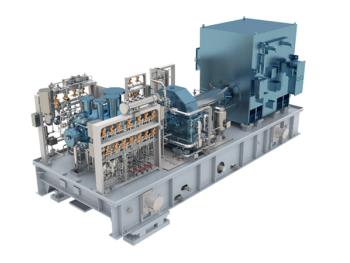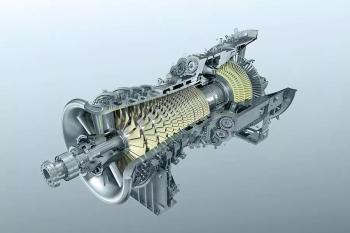
- September/October 2019
Air emission prevention
WHY REASONABLE EMISSION RULES SHOULD REPLACE
EXISTING NOX REDUCTION MANDATES
BY MANFRED KLEIN
Air priorities in the environment have changed over the past thirty years. It is likely, for example, that CO2 and fugitive methane emissions will overtake NOx and other pollutants as major new challenges. However, air pollutants, toxics and greenhouse gas (GHG) emissions come from the same sources. They can be prevented together. And efficient gas turbines (GTs) have a major role to play.
GTs, fueled mostly by natural gas and operating in conjunction with renewable energy, can provide large quantities of electrical and mechanical power, thermal heat and cooling services in an environmentally friendly manner. But there are a few facts that should be better understood.
Gas turbines are called that because their Brayton power cycle is based on air mass flow, not gas fuel. Natural gas is quite different that other types of fossil fuel as it is a hydrogen-based vapor that burns cleanly. Due to its low level of pollutants and CO2 emissions, local natural gas-based cogeneration and district energy offers an efficient and resilient energy cycle.
Advances in lean premix Dry Low NOx (DLN) combustion technology have lowered NOx emissions from the 150–300 ppm level of the 1980s to the 15–40 ppm level today, depending on the size and type of unit. This 90% reduction (3 kg/MWhr to 0.3–0.5 kg/MWhr) through cost-effective pollution prevention is unmatched by any other industrial sector and represents a major pollution prevention success story. However, while most DLN systems on large-frame engines work well, additional experience with new DLN systems in aeroderivatives and small units is required before users can be confident of their off-design operating ranges and reliability.
New hydrogen combustion systems that have high NOx but zero CO2 emissions could be credited with more flexible NOx requirements. It could also be claimed that with high-efficiency inlet air filtration capturing local ambient dust and volatile organic compounds (VOCs), there are no net particulate emissions from a modern GT system.
Reasonable emission limits
Most regions today have clean energy policies for efficiency, renewables and natural gas. When air pollution and GHG controls conflict with each other, the GT can sometimes get caught in the crossfire. It is recommended that governments and industry bodies switch to improving system efficiency and reliability instead of attempting to reduce NOx levels toward zero. It is unlikely that GTs emitting a moderate 25–30 ppm level of NOx have ever caused a significant air pollution problem.
If forced to further limit emissions to single-digit levels of 2–9 ppm, with high cost and little or no environmental benefit, the ability of GTs to participate with renewables on the grid will be limited. This would be the case, for example, if backend control with ammonia and Selective Catalytic Reduction (SCR) is used after DLN combustion to hit unrealistic NOx targets.
Ammonia-based liquids are dangerous to transport and handle, and SCR produces ammonia slip, particulates, and fouling of the Heat Recovery Steam Generator (HRSG). Additionally, catalytic systems with narrow temperature windows do not perform well in cycling. Their low temperatures may create nitrous oxide (N2O) as a greenhouse gas.
Low-ppm DLN combustors have been installed in large frame engines for peaking and combined cycles. However, smaller cogeneration units that are better matched to heat-to-power ratios for a thermal host have small combustors operating more reliably in the 25–40 ppm range. Operating ranges and start-up conditions could also be improved with simpler combustion designs, and the use of auxiliary duct burners. Low-ppm design requirements encourage larger plants, excessive fuel use, lower system reliability and collateral emissions from SCR.
In small GTs used for pipeline compression, reduced reliability may cause compressor engine trips that can lead to pipeline system upsets, methane venting and GHG releases. A more recent issue is the response to intermittent renewable energy. It requires flexible operating range and start-up/ shutdown cycles, which are difficult for both low NOx/CO combustion, and those using SCR systems. These and other issues call for a review of emissions policy to consider a broader view of environmental consequences instead of a rigid adherence to ppm limits.
Output-based emissions
One may wonder why gas turbines are still designed and regulated on the basis of NOx concentration (ppmv) standards when reciprocating engines, cars, aircraft and others use output-based standards, such as g/kWhr, g/mile or kg/1000 kg of thrust. A change is needed in the way emission rules are designed.
In 1992, a Canadian government- industry group produced a national guideline for GTs to promote cogeneration with low NOx emissions, based on grams of NOx per gigajoule of power output and GJ of heat output to promote cogeneration. These guidelines reflected cost-effective pollution prevention, CHP system efficiency and unit sizing while addressing both NOx and CO2 emissions. An update was published in 2016 to address larger GTs.
In 2006, the U.S. Environmental Prevention Agency issued a rule (40 CFR 60, subpart KKKK) to incorporate a lb/MWhr output-based emissions standard (OAR-2004-0490, amended in 2012) along with concentration-based rules. As with the Canadian rules, these did not require SCR and had a cogeneration thermal component with flexible emissions monitoring. More recently, several states have passed energy efficiency policies and laws to advance clean and renewable energy, mostly due to climate risk concerns. Most, however, still use ppmv standards for NOx/CO emissions.
A successful lb/MWhr (not ppmv) standard can allow for:
• More flexibility and reliability in clean energy system design. If these are applied to the plant instead of the unit, designers can think more about overall efficiency of power and heat and lower parasitic losses to minimize all emissions
• Recognition of the associated waste heat recovery system, HRSG and steam turbine or district energy piping, as useful “zero emission” or pollution prevent ion energy devices. A typical cogeneration plant with a H:P ratio of 1:1 will have a net CO2 rate of 250 kg (or 550 lb) per MWhr
• Better operation at transient load or changing ambient conditions if combustor mechanical design is not tied to low ppm constraints but rather to optimal power, fuel rate and mass flow. This allows better integration with wind and solar energy.
There is much discussion about life-cycle emissions, and how natural gas has half the GHGs of coal (cogeneration would be a net 70% reduction). A better way to conduct this analysis would be based on a combination of air pollutants, toxics and GHGs. A mix of gas turbine simple cycle, combined cycle and cogeneration systems would achieve a 70%-to-90% reduction in total air emissions compared with coal, if upstream methane emissions can be minimized.
Modern GT cogeneration plants represent a dramatic decrease in all air pollutants and carbon dioxide, while providing local reliability. With clean fuels, and in combination with all renewables and district energy, fuel cells and hydrogen systems, they represent a reasonably sustainable solution for at least the next 50 years. These topics will be considered at the upcoming Canadian Gas Turbine Energy Network conference in Banff Alberta, Oct 21–23, 2019 (
Manfred Klein is principal of MA Klein & Associates, a consulting firm specializing in natural gas energy systems, gas turbines, distributed energy and air emissions solutions. For more information, email maklein@rogers.com
Articles in this issue
about 6 years ago
Siemens prepares to launch energy companyover 6 years ago
Rotating machinery maintenanceover 6 years ago
The future of power generationNewsletter
Power your knowledge with the latest in turbine technology, engineering advances, and energy solutions—subscribe to Turbomachinery International today.




